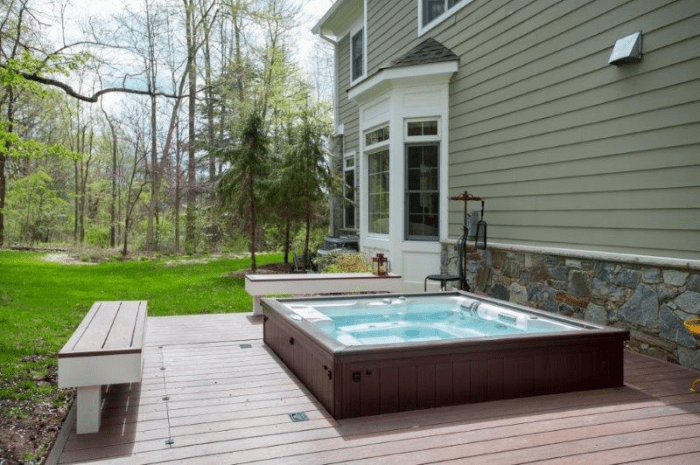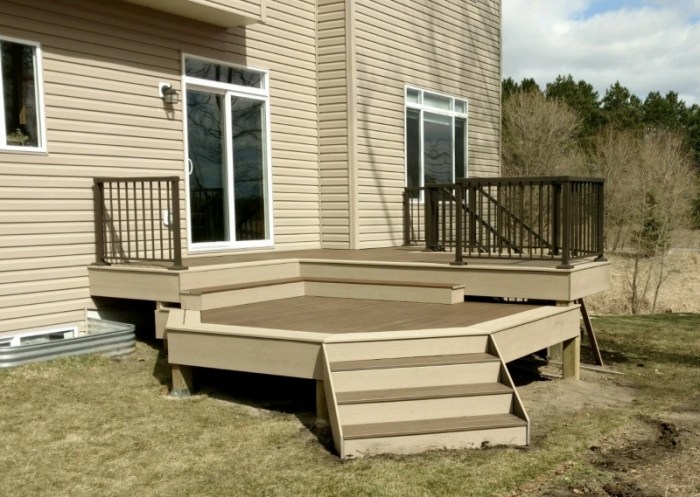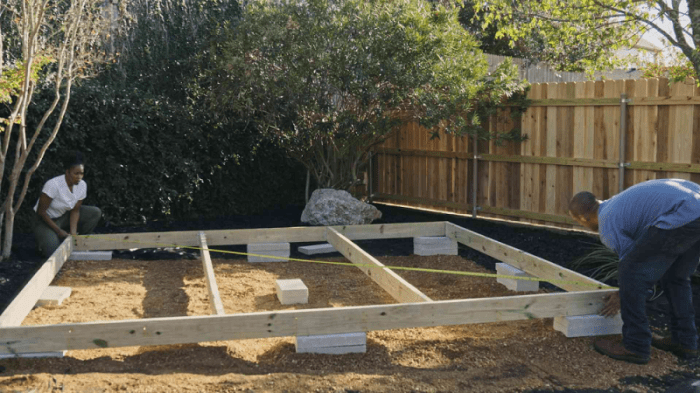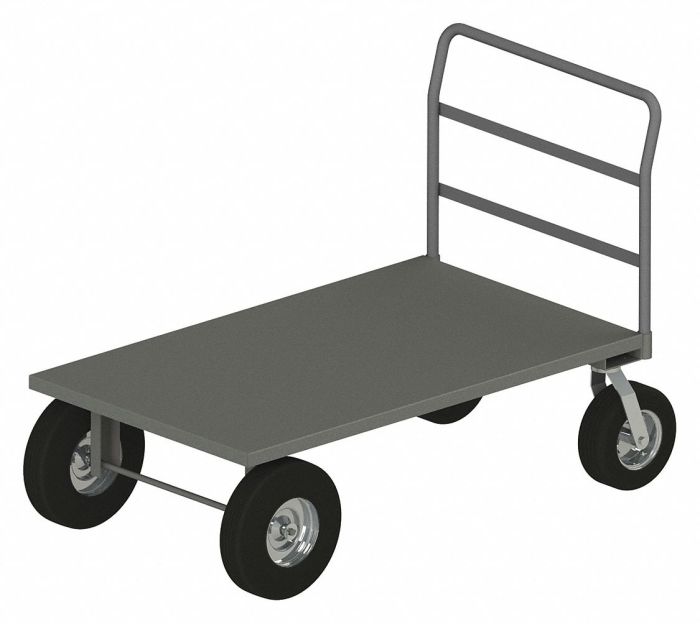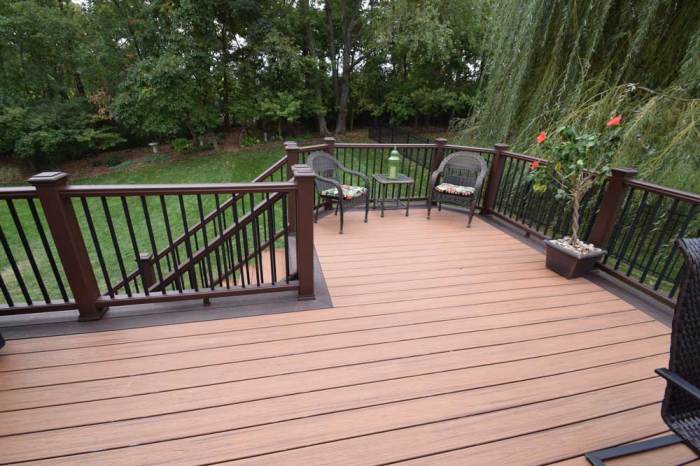Platform Deck with Pergola A Complete Guide
Platform decks with pergola designs offer a captivating blend of outdoor living and architectural sophistication. These structures seamlessly combine the practicality of a deck with the aesthetic appeal of a pergola, creating a space ideal for relaxation, entertaining, and enjoying the outdoors. From selecting the right materials to understanding the nuances of design and construction, this comprehensive guide delves into every aspect of creating your dream platform deck with ergonomics.
We’ll explore the diverse materials available, examining their strengths and weaknesses. Different design styles, from rustic to modern, will be presented, and considerations for size, shape, and location will be discussed. This guide also covers the construction process, maintenance, and durability, providing you with a detailed understanding of the entire project.
Introduction to Platform Decks with Pergolas
Platform decks with pergolas offer a seamless blend of outdoor living space and shade. These structures combine the functionality of a deck with the aesthetic appeal and protective features of a pergola, creating a versatile and inviting outdoor area. The design allows for comfortable relaxation, entertaining guests, and maximizing the enjoyment of the outdoors.
This style of deck provides a transition between indoor and outdoor living, enabling seamless integration of the two environments. The pergola’s structure adds a touch of elegance and style, while the platform deck offers a sturdy and comfortable surface for relaxing, dining, or simply enjoying the view.
Materials Commonly Used
A wide variety of materials are employed in the construction of platform decks with pergolas. Selection often depends on factors such as budget, desired aesthetic, and the local climate. Choosing the right material is crucial for longevity and performance.
- Wood: A classic choice for its natural beauty and warm aesthetic. Different types of wood, such as pressure-treated lumber or cedar, offer varying levels of durability and maintenance requirements. Consider the specific needs of your climate when selecting wood for your platform deck.
- Composite: A popular alternative to wood, composite decking materials are engineered to be low-maintenance and resistant to rot, insect damage, and fading. Their durability often translates to a longer lifespan compared to wood. The aesthetic options for composite materials are expanding, often mimicking the appearance of wood with a range of colors and textures.
- Metal: Metal, particularly aluminum or steel, provides exceptional durability and resistance to harsh weather conditions. Metal decks and pergolas can last a very long time with proper maintenance. Metal structures offer a modern, clean aesthetic that complements contemporary design styles. The smooth surfaces are often easier to clean compared to other materials.
Design Styles
Platform decks with pergolas can be tailored to a variety of design styles, from rustic to modern. The key is to select elements that harmonize with the overall aesthetic of the surrounding environment.
- Rustic: This style incorporates natural elements such as weathered wood, stone, and natural materials to create a warm, inviting ambiance. Rustic pergolas often feature a simple design with a focus on natural textures and earthy tones.
- Modern: Modern designs emphasize clean lines, geometric shapes, and minimalist aesthetics. Modern pergolas frequently utilize metal framing and sleek composite decking for a contemporary look.
- Transitional: This style blends traditional and modern elements, creating a harmonious combination of aesthetics. Transitional pergolas often feature a mix of wood and metal, and incorporate elements that allow for flexibility in use.
Material Comparison
The table below summarizes the key differences between wood, composite, and metal for platform decks with pergolas.
| Material | Durability | Maintenance | Cost | Aesthetic |
|---|---|---|---|---|
| Wood | Good, but susceptible to rot and decay | Requires regular staining and sealing | Moderate | Natural, warm, traditional |
| Composite | Excellent, resistant to rot, insects, and fading | Low, minimal maintenance | High | Modern, varied colors and textures, often mimicking wood |
| Metal | Excellent, highly durable | Low, easy to clean | High | Modern, clean, sleek |
Design Considerations
Designing a platform deck with a pergola requires careful consideration of various factors to ensure both aesthetic appeal and practical functionality. A well-designed space will seamlessly integrate the deck and pergola, enhancing the outdoor living experience. Proper planning will also ensure structural integrity, accessibility, and safety for all users.
A thoughtfully planned platform deck with a pergola will enhance the outdoor living space and improve the quality of life for the residents. Careful consideration of size, shape, location, and structural integrity, along with accessibility and safety features, is crucial for a successful design.
Size and Shape Considerations
The size and shape of the platform deck with pergola should be carefully determined to maximize its usability and visual appeal. Consider the size of the existing space, the intended use of the deck, and the number of people who will be using it. Rectangular, square, or even L-shaped designs are common, but creative designs like trapezoids or custom shapes can be explored depending on the site’s limitations. These choices will influence the amount of usable space for lounging, dining, or entertaining.
Location Selection
The location of the platform deck with a pergola is a critical factor. Consider the prevailing winds, sunlight exposure, and views. A well-chosen location will maximize the enjoyment of the outdoor space while minimizing potential issues like excessive shade or wind exposure. Placement near existing structures, such as a house or other outbuildings, will need careful planning to avoid overshadowing or impacting existing structures. Properly assessing the proximity to utilities like water lines or electrical outlets is crucial for future installation and maintenance.
Structural Considerations
Incorporating a pergola into a platform deck design requires robust structural support. The pergola’s weight, along with the weight of the deck itself and any anticipated loads (furniture, people, etc.), must be accounted for in the design. High-quality lumber, properly sized beams, and sturdy posts are essential for the structure’s stability and longevity. The structural design must also address the anchoring of the pergola to the deck, ensuring both are supported adequately and securely connected.
Accessibility and Safety Features
Ensuring accessibility and safety is paramount in platform deck design. Ramps, handrails, and non-slip surfaces should be included for safe movement. Proper lighting, especially at night, is vital for nighttime use. Accessibility for people with disabilities should be incorporated into the design, ensuring ramps and appropriate handrails are accessible and usable for all. Compliance with local building codes and safety regulations is critical.
Size and Shape Suitability Table
| Deck Size (sq ft) | Shape | Suitable for |
|---|---|---|
| 100-150 | Square/Rectangular | Small to medium-sized properties, single-family homes |
| 150-250 | Rectangular/L-shaped | Medium-sized properties, multi-family homes, and townhouses |
| 250+ | Custom/Irregular | Large properties, estates, and commercial spaces |
Safety Guidelines and Regulations Table
| Safety Feature | Description | Regulation/Code (Example) |
|---|---|---|
| Handrails | Required on all open sides of the deck | Local Building Codes |
| Non-slip Surfaces | Essential for all walking areas | Local Building Codes |
| Lighting | Adequate lighting for nighttime use | Local Building Codes |
| Accessibility | Ramps and handrails for people with disabilities | ADA Compliance |
| Structural Integrity | Design must withstand anticipated loads | Local Building Codes |
Construction Methods
Constructing a platform deck with a pergola involves a meticulous process, requiring careful planning and execution. Proper attention to detail ensures structural integrity and aesthetic appeal, maximizing the lifespan of the entire structure. The foundation, support systems, and attachment methods for the pergola are critical to achieving a stable and attractive final product.
Building a platform deck with a pergola requires a comprehensive understanding of each stage, from laying the foundation to installing the roofing. This section articulates the key steps involved, including the various methods for securing the pergola to the deck, along with the diverse materials suitable for roofing the structure. Careful consideration of these elements will lead to a durable and aesthetically pleasing outdoor living space.
Foundation and Support Systems
The foundation and support systems are the bedrock of any platform deck, especially when a pergola is integrated. A robust foundation is essential to support the weight of the deck, pergola, and any anticipated loads. Properly designed support systems ensure stability and longevity, preventing sagging or other structural issues. The depth and type of foundation will vary depending on local soil conditions and the overall design of the structure. Concrete footings are a common choice for platform decks due to their strength and durability.
- Excavation and Trenching: The initial step involves excavating trenches to the appropriate depth, considering the necessary clearance for the footings. Careful measurements and precise digging are critical to avoid any issues with leveling.
- Pouring Concrete Footings: Once the trenches are prepared, concrete footings are poured and allowed to cure according to the manufacturer’s recommendations. Ensuring the footings are level and plumb is paramount.
- Installing Deck Framing: The deck framing is assembled on top of the cured concrete footings, providing the structural support for the entire platform deck.
- Placement of Beams and Posts: The beams and posts for the pergola are strategically placed on the deck framing, securing the pergola’s structure and aligning it with the deck’s overall design.
Pergola Attachment Methods
Various methods exist for attaching the pergola to the deck structure, each with its advantages and disadvantages. The choice depends on the design of the pergola, the material of the deck, and local building codes. Properly securing the pergola to the deck is crucial to prevent movement and ensure the longevity of both components.
- Bolting: Bolting is a common and reliable method for attaching the pergola to the deck. High-strength bolts are typically used, providing a strong and secure connection.
- Welding: Welding is another strong option for joining the pergola to the deck frame. However, it requires specialized skills and equipment, and may not be suitable for all deck materials.
- Using Brackets: Brackets provide a secure connection point between the pergola and the deck. The type and size of brackets will depend on the weight and dimensions of the pergola.
Roofing Materials
The choice of roofing material for the pergola significantly impacts the aesthetic appeal and durability of the entire structure. Consider factors such as weather conditions, budget, and desired aesthetic when making this selection.
- Wood: Wood is a traditional and aesthetically pleasing option. However, it requires regular maintenance and can be susceptible to weather damage.
- Composite Materials: Composite materials offer a low-maintenance alternative to wood. They are resistant to rot and decay, and come in various colors and textures.
- Metal Roofing: Metal roofing is durable and resistant to weather damage. It offers a modern aesthetic and is available in different colors and finishes.
- Fabric/Canopy Materials: Fabric or canopy materials provide shade and can be easily installed. They are generally more affordable than other roofing options, but may not be as durable in extreme weather conditions.
Construction Process
The construction process for a platform deck with a pergola should follow a specific sequence, ensuring the safety and stability of the structure.
- Foundation Preparation: Excavate, install footings, and ensure proper leveling. This initial stage lays the groundwork for the entire structure’s stability.
- Deck Framing: Construct the deck framing using appropriate lumber and fasteners. Accurate measurements and proper alignment are crucial.
- Pergola Frame Assembly: Assemble the pergola frame according to the design specifications. Pay attention to support structures and the connection points.
- Pergola Attachment: Secure the pergola to the deck using the chosen method (e.g., bolting, welding, brackets). Ensure all connections are secure and structurally sound.
- Roofing Installation: Install the chosen roofing material on the pergola, ensuring proper sealing and adherence to the design.
- Finishing Touches: Install railings, stairs (if applicable), and any other finishing elements.
Maintenance and Durability
Maintaining a platform deck with a pergola requires a proactive approach to ensure its longevity and aesthetic appeal. Proper upkeep not only extends the lifespan of the structure but also minimizes potential safety hazards. This section delves into the various maintenance methods, the durability of different materials, and the impact of weather on these structures.
Maintenance Methods
Regular cleaning and inspections are key to preserving the structural integrity and aesthetic appeal of the platform deck and pergola. Cleaning methods should be tailored to the specific materials used in construction. For instance, pressure washing can be effective on composite decking, while softer methods are necessary for wood or other delicate materials. Inspections should be conducted regularly to identify any signs of wear and tear, such as loose fasteners, rot, or damage from weather. Addressing these issues promptly prevents small problems from escalating into costly repairs.
Material Durability
The durability of materials significantly impacts the long-term performance of the platform deck and pergola. Wood, a traditional choice, requires regular treatment to prevent decay and insect infestations. Composite materials, often favored for their low-maintenance qualities, offer excellent resistance to moisture and rot, though they can be susceptible to certain types of damage from extreme weather. Aluminum and steel, while durable, can be prone to rusting if not properly maintained. The specific choice of material should be carefully considered about the anticipated climate and the owner’s commitment to upkeep.
Impact of Weather Conditions
Weather conditions significantly influence the durability of platform decks and pergolas. Exposure to prolonged sunlight, heavy rainfall, and extreme temperatures can lead to material degradation. UV rays can fade or damage the finish of decking materials. Water penetration can cause rot or warping in wood and structural damage in other materials. Wind can cause damage to the structure or detach components, and ice buildup can place excessive stress on the system. Proper design considerations and material selection can mitigate these effects.
Maintenance Task Schedule
| Task | Frequency | Procedure |
|—|—|—|
| Cleaning (exterior) | Weekly/Monthly (depending on use and weather) | Use mild detergent and water for wood, pressure washer for composite, avoid harsh chemicals. |
| Inspection (structure) | Quarterly | Check for loose fasteners, cracks, or damage. Inspect for signs of rot or insect activity. |
| Cleaning (interior/underneath) | Twice a year | Clear debris and clean any gutters or drainage systems to prevent water accumulation. |
| Treatment (wood) | Annually | Apply sealant or stain as needed. Replace any damaged or decaying wood components. |
| Repair (damage) | As needed | Address any identified issues promptly. |
| Gutter/drain cleaning | Twice a year | Remove debris from gutters and downspouts. Ensure proper drainage. |
Potential Problems and Solutions
- Rot and Decay: Wood decks are susceptible to rot and decay, particularly in areas with high moisture. Solutions include regular treatment with wood preservatives, prompt repair of any damaged areas, and proper drainage.
- Rust and Corrosion: Metal components, such as railings or fasteners, can rust or corrode over time. Solutions include regular cleaning and protective coatings to prevent corrosion, and prompt replacement of rusted or damaged components.
- Moisture Damage: Water penetration can lead to structural damage and mold growth. Solutions include addressing any leaks, proper drainage around the deck, and ensuring gutters are functioning correctly.
- Insect Infestation: Wood decks can be susceptible to insect infestation. Solutions include using preventative treatments and prompt treatment of any identified infestations.
Functionality and Uses: Platform Deck With Pergola
Platform decks with pergolas offer a versatile extension of outdoor living space, transforming a simple patio into a sophisticated and functional outdoor room. This versatility stems from the combination of a sheltered, shaded area provided by the pergola and the open, spacious feel of the platform deck. The unique combination creates an ideal environment for a variety of activities and relaxation.
A thoughtfully designed platform deck with a pergola can significantly enhance the enjoyment and utility of an outdoor space. The ability to create shade and shelter is key, allowing for comfortable use throughout the day, regardless of the weather. Strategic placement of outdoor furniture and lighting further elevates the space’s appeal, inviting both social gatherings and quiet moments of reflection.
Different Uses and Functionalities
Platform decks with pergolas can be used for a wide range of activities. They serve as excellent spaces for dining al fresco, hosting gatherings, or simply relaxing and enjoying the fresh air. Their adaptability allows for a transition from casual gatherings to more formal events, making them highly functional.
Enhancing Outdoor Living Space, Platform deck with pergola
The pergola structure itself dramatically enhances the outdoor living space. Its shade-providing canopy creates a protected area, extending the usability of the deck beyond the limitations of direct sunlight. This increased usability allows for longer hours of enjoyment and accommodates a wider range of activities. The pergola’s aesthetic appeal adds a touch of elegance and sophistication to the overall design.
Creating a Comfortable and Inviting Atmosphere
The creation of a comfortable and inviting atmosphere is achieved through careful consideration of outdoor furniture and lighting. Choosing furniture that is both durable and comfortable is essential for long-term enjoyment. Materials like teak, wicker, or aluminum, chosen for their weather resistance, ensure the furniture remains attractive and functional for many years. Strategically placed outdoor lighting, such as string lights or lanterns, sets a warm and inviting ambiance, making the space perfect for evening gatherings.
Incorporating Outdoor Furniture and Lighting
The selection of outdoor furniture should complement the overall design aesthetic and the activities planned for the space. Dining sets, lounge chairs, and occasional tables are all possibilities. The choice should consider the intended use, size of the deck, and personal preferences. Lighting is equally important. Solar-powered path lights, string lights draped along the pergola, or lanterns strategically placed can transform the space into a warm and inviting haven after sunset.
Examples of Activities
- Dining al fresco: Enjoying meals under the pergola’s shade, with the fresh air and ambiance adding to the dining experience.
- Hosting gatherings: The space can accommodate gatherings of various sizes, from intimate family dinners to larger parties. The pergola’s shade and platform’s layout can be adapted for different group sizes.
- Relaxing and enjoying the fresh air: Simply sitting back and taking in the scenery, enjoying the fresh air, and soaking in the ambience of the outdoor space.
- Outdoor entertainment: Setting up a barbecue area or incorporating a fire pit for evening entertainment.
- Gardening and relaxing: The deck provides a perfect location to cultivate and tend to plants, or simply relax amongst the greenery, with the pergola offering shade from the elements.
Cost and Budget Considerations
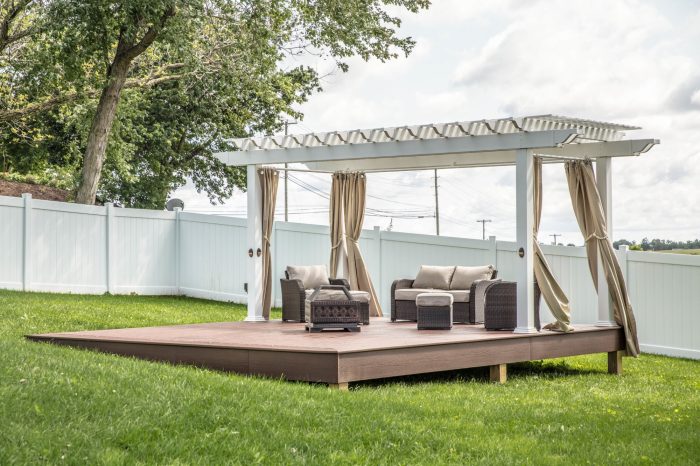
Source: integrous.com
Constructing a platform deck with a pergola involves careful budgeting. Accurate cost estimations are crucial to avoid surprises and ensure the project stays within the desired financial parameters. Understanding the factors influencing the total cost, from material selection to labor expenses, is vital for a successful project.
Estimated Cost Breakdown
A platform deck with a pergola can range in cost significantly, depending on several factors. A general estimate for a moderate-sized project, covering 150 square feet of decking with a 10×10 pergola, could fall between $15,000 and $30,000. This is a wide range; factors such as material choices, labor rates in the specific area, and the complexity of the design will all influence the final price. Lower-end estimates might apply to simpler designs with standard materials. Higher-end estimates would encompass premium materials, elaborate designs, or specialized features.
Factors Influencing Overall Cost
Several elements influence the final cost of a platform deck with a pergola. Size, complexity of the design, material choices, location, and labor rates all contribute to the total expense. A larger deck and pergola will inherently cost more than a smaller one. Custom features, intricate designs, and specialized materials, such as exotic hardwoods or custom lighting, increase the overall cost. Geographic location also plays a role, as labor costs and material prices can fluctuate regionally.
Cost of Different Materials
The cost of materials is a significant component of the project budget. Different types of lumber, decking, and roofing materials vary greatly in price. For example, pressure-treated lumber is typically more affordable than composite decking, while composite decking often proves more durable in the long run. Metal roofing for the pergola, for instance, could be more expensive than a wooden alternative.
Cost of Labor
Professional labor costs should also be factored into the budget. The complexity of the construction, the experience level of the contractors, and local labor rates will impact the cost. Detailed plans and precise measurements can minimize unexpected labor charges. Hiring a general contractor for oversight can be a considerable cost, but it can often streamline the project and mitigate potential issues.
Material Cost Comparison
| Material Category | Pressure-Treated Lumber | Composite Decking | Cedar Wood | Metal Roofing |
|—|—|—|—|—|
| Platform Deck | $5-$15/sq ft | $10-$25/sq ft | $12-$20/sq ft | N/A |
| Pergola Structure | $8-$18/sq ft | N/A | $10-$20/sq ft | $15-$30/sq ft |
| Roofing | N/A | N/A | N/A | $5-$15/sq ft |
Ways to Reduce Overall Cost
Several strategies can help reduce the project cost without sacrificing quality. Choosing more affordable materials, such as pressure-treated lumber for the platform, can significantly decrease expenses. Simplifying the design, opting for standard features, and negotiating with contractors can also save money. Prioritizing DIY tasks, where applicable and feasible, for less complex elements can further reduce labor costs. Pre-planning and detailed measurements are crucial to avoid costly revisions and errors. Additionally, securing competitive bids from multiple contractors can ensure the most advantageous pricing.
Outcome Summary
In conclusion, building a platform deck with a pergola is a rewarding project that can transform your outdoor space. By carefully considering design elements, construction methods, and long-term maintenance, you can create a beautiful and functional outdoor living area. The guide has provided a roadmap for every step of the process, from initial design to final touches, ensuring a successful and enjoyable outcome. Remember to prioritize safety and durability throughout the project, and embrace the opportunity to personalize your space to your specific needs and preferences.
